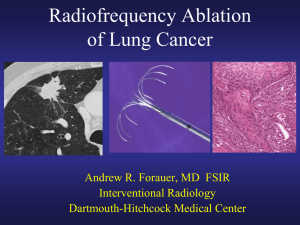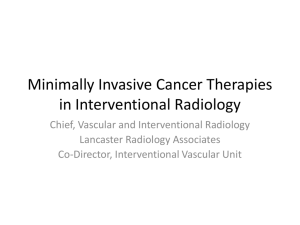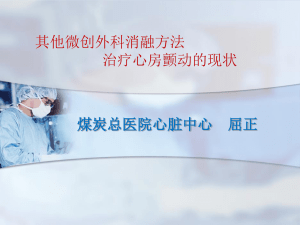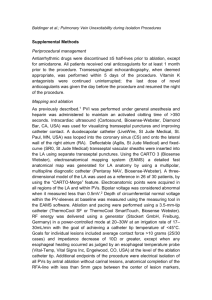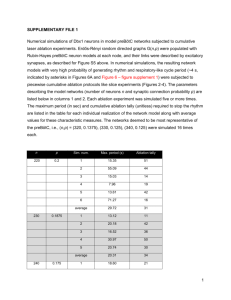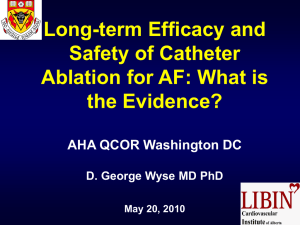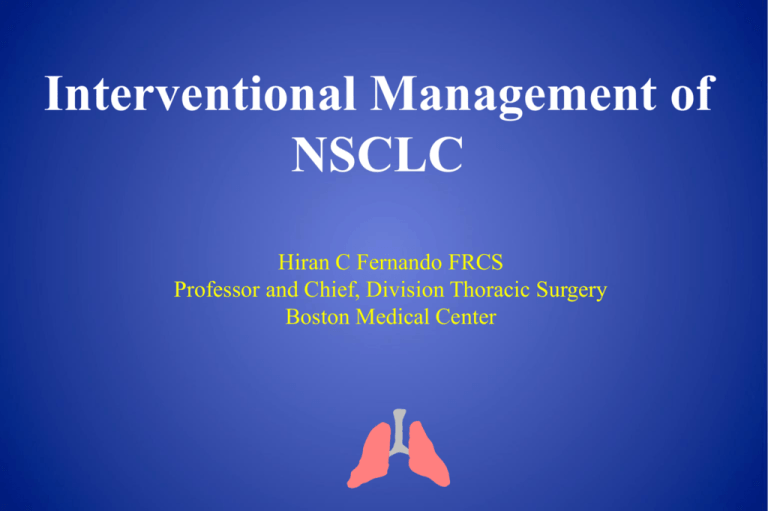
Interventional Management of
NSCLC
Hiran C Fernando FRCS
Professor and Chief, Division Thoracic Surgery
Boston Medical Center
Comparison of MWA and RFA
Qiang Lu et al; AATS 2015
• 141 patients; 100 with NSCLC/ 41 with mets
• First comparative study of MWA and RFA for lung
• Randomized study
– RFA 69; MWA 72
• Conclusions;
– No difference in survival
– MWA superior for local control for tumors >3cm
• Size matters!
Thermal Ablative Therapies for NSCLC
• Radiofrequency ablation (RFA)
• Most published data
• Microwave ablation (MWA)
• Irreversible Electroporation (IRE)
• Direct Current ; No published lung data
• Cryoablation (Cryo)
• Bronchoscopic Ablation (BsAb)
RFA system
• 3 components
• An RFA generator
• An active electrode
• Dispersive electrodes (bovie pads)
• RF energy (alternating current ) moves from the
active->dispersive->active electrodes, resulting in
frictional heating of tissue
• When temperature >60° C, tissue dies
• Most systems will heat around 90-100 °C
Active electrode
Patient return pads
(4 total; 2 on each thigh)
RF generator
Boston Scientific
RITA
Valley Lab
RFA survival for Stage 1 NSCLC
Author (n) Median Median 1yr
FU
Survival
2yr
5yr
Lanuti
(31)
Pennathur
(13)
Hiraki
(50)
Dupuy
(75)
17m
30m
85%
78%
NR
28m
Not
reached
95%
68%
NR
37m
67m
94%
86%
NR
NR
29m
78%
57%
27%
NR =not recorded
Percutaneous Thermal Ablation for
Stage IA Non-Small Cell Lung Cancer:
Long-term Follow-Up
Chaitan K. Narsule1, Divya Nair1, Avneesh Gupta2,
Roy G. Oommen3, Michael I. Ebright4, Virginia R. Litle1,
Hiran C. Fernando1
1Division
of Thoracic Surgery, Boston University School of Medicine, Boston, MA
of Radiology, Boston University School of Medicine, Boston, MA
3The Thoracic Associates, Stoughton, MA.
4Division of Thoracic Surgery, Columbia University, New York, NY
2Department
BMC Results; Thermal Ablation
Stage I NSCLC
• 21 Lung tumors ≤ 3 cm in max diameter by CT scan of lungs
– Median FEV1%=39%
– Median DLCO%=37%
• 18 had RFA
• 3 had microwave
• Mediastinoscopy
– Suspicious nodes by CT/PET
Presented; ISMICS 2014
BMC; Follow-Up after RFA (stage 1)
• Mean follow-up: 42 months
• Overall survival:
– 2 years: 81%
– 3 years: 52%
• Median survival: 39 months
• Local progression : 10 patients (47.6%)
• Median time to local progression: 35m
• 3 treated with SBRT
• 3 retreated with ablation
Radiofrequency Ablation of Stage 1A NSCLC in
Medically Inoperable Patients: Results from ACOSOG
Z4033 (Alliance), an NCI Funded Multicenter Trial
Damian E. Dupuy1, Hiran Fernando2, Shauna Hillman3, Thomas Ng1,
Angelina D. Tan3, Jo-Anne Shepard4, William Rilling5, Kelvin Hong6, Joe
B. Putnam7
In Press; Cancer 2015
Z4033; Study Design
•
•
•
Single arm pilot trial
55 medically inoperable patients
Histology confirmed NSCLC
Objectives
•
Primary Objective
• Two year survival
•
Secondary Objectives
• Establish procedure specific morbidity and mortality
• Freedom from local recurrence* at 2-years
• Freedom from distant recurrence at 2-years
•
*Local recurrence includes recurrence within the same lobe or hilum (N1 nodes)
or progression at the ablated site after treatment effects have subsided
Results
Grade 3 AE’s possibly related to treatment
(0-3 months)
AE Type
N (%)
Constitutional Symptoms
Fever
1 (2%)
Infection/Febrile Neutropenia
Colitis, Infectious
1 (2%)
Infection – other, specify
1 (2%)
Pulmonary
Dyspnea (shortness of breath)
1 (2%)
Hypoxia
1 (2%)
Pleural effusion
1 (2%)
Pneumonitis/pulmonary
infiltrates
1 (2%)
Pneumothorax
2 (4%)
• Grade 3 AE rate = 12%
• No Grade 4 or 5 AEs
• Two Grade 3 PTX
requiring intervention
Z4033; Overall Survival
100
90
80
% Survival
70
60
50
N= 51
No. Event= 15)
Survival Rate at 1 year: 86.3%
Survival Rate at 2 year: 69.8%
40
30
20
10
0
0
0.2
0.4
0.6
0.8
1
1.2
1.4
Follow-up Time (Years)
1.6
1.8
2
RTOG 0236; Overall Survival after SBRT
Overall Survival (%)
100
75
36 month
/
overall survival = 56% (CI: 42-68%)
/ /
/ //
50
Dead:
Total:
MST:
(95% CI):
25
26
55
48.1
(29.6, not reached)
0
0
6
Patients
at Risk
55
54
12
18
24
30
Months after Start of SBRT
47
46
40
35
• Median survival is 48.1 months
36
24
Z4033; Local Recurrence
100
90
%Local Recurrence Free
80
70
60
50
N=51
No. Event = 19
Local Recurrence Free Rate at 1 year: 68.9%
Local Recurrence Free Rate at 2 year: 59.8%
40
30
20
10
0
0
0.2
0.4
0.6
0.8
1
1.2
Follow-up Time (Years)
1.4
1.6
1.8
2
Z4033; Impact of Size on Outcomes
• Tumor size significantly (p=0.049) associated with
overall survival at 2-years
– <2cm; 78%
– ≥2cm; 58.1%
• Tumor size ; non-significant trend (p=0.406) for local
progression free survival at 2-years
– <2cm; 63.7%
– ≥2cm; 56.1%
Microwave Ablation
• Several systems in USA, Europe;
• Covidien (Evident), Microtherm-X, AveCure
• Covidien (Emprint) Certus 140, Acculis,
(915-MHz)
(2.45GHz)
• Require multiple or single probe placements for similar
ablation
• No trials comparing systems
• Oncological outcomes
• Safety
Microwave Ablation
BSD MicrothemX
(915 MHz)
Covidien ;Emprint (2.45GHZ)
Neuwave (2.45 GHZ
Differences Between MWA and RFA
• Higher frequencies have
shorter wavelengths
• Amplitude
RF
(470
kHz)
MW
(915 MHz,
2.45GHZ)
In
AIR
0.64km
30cm
In
TIS
SUE
91m
~4-5cm
~7.6 cm in liver
tumor
– Applied voltage or current
RF & MW Circuit Diagrams
• RF
• Circuit pathway
• Electrode passes current
• MW
• No current flow through
patient
• Antenna radiation
Cryoablation
Cryohit (Galil Medical, Yokneam, Israel)
Cryocare (Endocare, Irvine, CA, USA)
Cryoablation
•
•
•
•
•
1.5, 1.7 and 2.4mm percutaneous probes
Argon based systems
Ice ball visible with CT,US, MRI
Relatively painless during treatment
Multiple applicators
Stage I NSCLC; Results after Microwave
& Cryoablation
Author (n)
Modality
Ablation
Median
Follow-up
1-yr Overall
Survival
2-yr Overlall
Surviva;
3-year
Overall
survival
Wolf (50)
Microwave
10months
65%
55%
45%
Yang (47)
Microwave
30months
89%
63%
43%
Yamauchi
(22)
Cryoablation 23months
N/A
88%
88%
N/A
N/A
77%
Zemlyak (27) Cryoablation 33months*
N/A=not available
*median follow-up included patients treated with RFA and surgery
Bronchoscopic Ablation of peripheral
tumors
• Next step in evolution therapies for NSCLC
• Potentially allow Dx and Rx-in same setting
• Lower risk of pneumothorax compared to
percutaneous approaches
• However need improvements in
– Navigation technology (accuracy of probe placement)
– Available flexible ablation systems
EN Bronchoscopy
Number
patients
Successful
Diagnosis -
Pneumothorax
rate
Lamprecht
(2012)
112
83.9%
1.8%
Pearlstein
(2012)
104
82% -true
malignant
5.8%
Eberhardt
(2007)
89
67%
2.2%
Requirements for EN Bronchoscopy for
Successful Ablation
• Need 100% accuracy of probe placement
– unlike requirement for fiducial placement for SBRT
• Need to be sure about orientation of ablation probe to
tumor to ensure optimal ablation achieved
– Real-time CT scan confirmation of bronchoscopic probe
– ? fiducial placement that could be tracked by ENB system
Bronchoscopic-guided MWA ablation
Ferguson J et al. Chest 2013:144;37A
• Animal study;
• 4 ablations (different power /time settings)
• 3 pigs
• 12 ablations performed
• Neuwave 17 gauge antenna via bronchoscope
• Successful oval shaped ablations created (1.2-3.7cm
in short axis)based on power used
Study 3 Different Bronchoscopic RFA catheters
Tanabe T et al. Chest 2010 ;137(4):890-897
• Ten patients cT1N0M0 had bronch ablation prior to
planned resection
• 3 probe sizes –active tip (5mm, 8mm, 10mm)
• Bronch navigation with CT flouroscopy
• No complications (no PTX)
Date of download: 2/14/2013
Copyright © American College of Chest Physicians. All rights reserved.
From: Comparative Study of Three Different Catheters for CT Imaging-Bronchoscopy-Guided
Radiofrequency Ablation as a Potential and Novel Interventional Therapy for Lung Cancer
CHEST. 2010;137(4):890-897. doi:10.1378/chest.09-1065
Internally cooled radiofrequency ablation (RFA) electrodes. The shaft (arrows) and tip of the electrode
(arrowheads) are shown (A). The top electrode produced power output and measured the tip temperature
and impedance. Three types of the tip were used: 5-mm cylindrical active tip (B); 8-mm active tip with four
beads (C); and 10-mm active tip with five beads (D).
Date of download: 2/14/2013
Copyright © American College of Chest Physicians. All rights reserved.
From: Comparative Study of Three Different Catheters for CT Imaging-Bronchoscopy-Guided
Radiofrequency Ablation as a Potential and Novel Interventional Therapy for Lung Cancer
CHEST. 2010;137(4):890-897. doi:10.1378/chest.09-1065
Figure Legend:
Comparison of area of RFA with the three different tips. The area of RFA lesion using an
internally cooled electrode with the 10-mm tip with five beads was significantly larger than
that using the electrode with a 5-mm cylindrical catheter tip. Values are means ± SEM; *P <
.05. See Figure 1 legend for expansion of abbreviation.
Clinical Cases Bronchoscopy guided-RFA
Koizumi T et al; Case Reports on Oncol Med; 2013 ID 515160
• Two patients treated with bronchoscopy guided
ablation only
• No recurrence at 4 and 3.5 years respectively
• 1 patient developed local recurrence and was
treated with repeat bronchoscopy guided ablation
Conclusions; Thermal Ablation
• Good therapy for medically inoperable and ?high-risk
operable patients
• Survival at two years as good as SBRT
• Thermal ablation technologies are evolving
– Futher studies comparing MWA systems and different
technologies needed
• Approaches are also evolving
– Bronchoscopic ablation may soon be feasible


